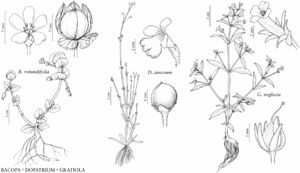Gratiola neglecta
Cat. Pl. New York, 89. 1819.
Annuals. Stems ascending or erect, few to much-branched, rarely simple, (4–) 10–40 cm, glabrous or glandular-puberulent proximally, glandular-puberulent distally. Leaves: blade linear to narrowly elliptic, oblanceolate, or elliptic-obovate, rarely falcate, 10–65 × 3–11 (–18) mm, margins with (1 or) 2–5 (–7) pairs of blunt to sharp teeth, apex acute, surfaces glabrate or glandular-puberulent. Pedicels slender, 8–35 mm, length (0.3–) 0.4–0.9 (–1.3) times bract, sparsely to densely glandular-puberulent; bracteoles 2, 2.5–7 mm. Flowers: sepals distinct, lanceolate to narrowly lanceolate-elliptic, 2.5–6 mm; corolla 7–12 mm, tube yellow, yellowish white, or yellowish green, veins brownish violet, limb white, sometimes tinged lavender; style 3–4 mm. Capsules ovoid, 2.6–6 × 3–5 mm. Seeds 0.4–0.7 mm. 2n = 14, 16.
Phenology: Flowering Mar–Oct.
Habitat: Wet meadows, stream banks, shorelines of ponds, mudflats, salt marshes, crop fields.
Elevation: 0–2400 m.
Distribution
Alta., B.C., Man., N.B., N.S., Ont., Que., Sask., Ala., Ariz., Ark., Calif., Colo., Conn., Del., D.C., Ga., Idaho, Ill., Ind., Iowa, Kans., Ky., La., Maine, Md., Mass., Mich., Minn., Miss., Mo., Mont., Nebr., Nev., N.H., N.J., N.Mex., N.Y., N.C., N.Dak., Ohio, Okla., Oreg., Pa., R.I., S.C., S.Dak., Tenn., Tex., Utah, Vt., Va., Wash., W.Va., Wis., Wyo., in Europe (Finland), in Europe (France)
Discussion
Gratiola neglecta exhibits the widest range and broadest ecological amplitude of the North American Gratiola species. Besides occurring in a variety of freshwater wetland communities, it sometimes is found in salt marshes and damp or wet agricultural fields.
Selected References
None.
Lower Taxa
"(" is not declared as a valid unit of measurement for this property.
